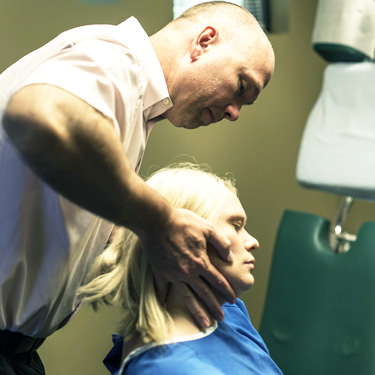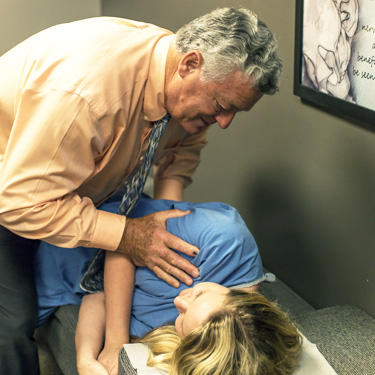What makes us so special?
Chiropractic has come a long way since Daniel D. Palmer gave his first adjustment in September 1895 in Davenport, Iowa. Today, there are many methods used by chiropractors to correct spinal misalignments, joint dysfunctions and subluxation complexes. Many techniques are identified by the name of the person who was most instrumental in their development. Interestingly enough, one of the most advanced and scientific methods is a technique called:
The Gonstead System
Gonstead procedures are the result of extensive clinical research by Clarence S.Gonstead, founder of the world famous Gonstead Clinic of Chiropractic in Mount Horeb, Wisconsin and his associates. Doctor Gonstead’s fifty-five years of continuous practice and over four million chiropractic adjustments resulted in the most complete method of biomechanical analysis available for use by today’s doctors of chiropractic. So why don’t all chiropractors use this technique? Because the analysis takes more time and mastering the art of delivering a specific adjustment takes a LOT of practice and dedication.
The “Gonstead Chiropractor”
The Gonstead Chiropractor goes beyond what many chiropractors consider a spinal assessment by conducting a thorough analysis of your spine using five criteria to detect the presence of the vertebral subluxation complex.
- Visualization — Visualization is a way to cross reference all the other findings. Your chiropractor is an expert in looking for subtle changes in your posture and movement which could indicate any problems.
- Instrumentation — The instrument of choice in the Gonstead System is the Nervoscope. The Nervoscope detects uneven distributions of heat along the spine which can be indicative of inflammation and nerve pressure. This instrument is guided down the length of your back and feels like two fingers gliding down each side of your spine.
- Static Palpation — This is simply the process of feeling (or palpating) your spine in a stationary (or static) position. Your chiropractor will feel for the presence of swelling (or edema), tenderness and any abnormal texture or tightness in the muscles and other tissues of your back.
- Motion Palpation — This process involves feeling the spine while moving and bending it at various angles. This enables the chiropractor to determine how easily or difficult each segment in your spine moves in different directions.
- X-Ray Analysis — X-ray films enable your doctor to visualize the entire structure of your spine. This is helpful in evaluating posture, joint and disc integrity, vertebral misalignments and ruling out any pathologies, or recent fractures that may be present or contributing to the patient’s condition. These full-spine radiographs are taken in the standing, weight-bearing position to fully substantiate the examination findings.
Basic Principles
The Basic Principles of the Gonstead Method of Chiropractic Analysis
The Gonstead Concept of chiropractic begins with a basic biomechanical principle of physics. Every engineer, architect, builder and carpenter knows the importance of a proper foundation in constructing a building, for this insures durability and long life. Any slight change or shift in the foundation can cause a great amount of deviation in the top part of the structure and, perhaps, ultimately, its collapse.
The body’s foundation is formed by the pelvic girdle. When this bony structure consisting of hip bones and the lower bones of the back is level, there will be maximum balance and stability in the spinal column. When the pelvic girdle or any of the vertebrae (bones making up the spinal column) become tilted or rotated out of their proper position, dramatic changes may occur in the body.
Read More About the Basic Principles
In order to more fully understand what occurs, we should know that the discs are really pads between the vertebrae and consist of a spongy substance surrounded by fibers of cartilage. When there is misalignment of a vertebra, there is uneven pressure on the disc causing it to swell and protrude. (One often hears this referred to as a slipped, herniated or ruptured disc.)
Chiropractors call this condition a SUBLUXATION when it results in the pinching or compressing of the nerves that run through that particular area. These compressed nerves often become inflamed and impede the proper transmission of impulses to the section of the body controlled by these nerves. A seemingly endless list of ailments and pain may be brought about by these subluxations.
Generally, misaligned vertebrae in the spine are easily recognized, particularly those in the upper portion of the vertebral column. However, less easily found and often overlooked are misalignments in the foundation or lower portions of the spine.
The ability to recognize and correct these misalignments forms an integral part of the Gonstead Concept. For example: When the lower portion of the spinal column has misaligned vertebra, the body tries to keep itself and its skeleton upright and straight. Often it compensates by causing a vertebra above to become misaligned. This is the body’s way of attempting to re-establish the normal perpendicular position of the body.
If just the top misaligned vertebra was adjusted, in cases where additional vertebrae are misaligned, only limited relief could result. This would not be getting to the source of the trouble. For complete and lasting results, all of the misaligned vertebrae must be identified and then a program can be initiated to restore them to their normal position. Every chiropractic case presents a different combination of misaligned vertebrae.
The Gonstead Adjustment
After a complete analysis, the Gonstead chiropractor is ready to deliver any necessary adjustments. The focus of the Gonstead adjustment is to be as specific, precise and accurate as possible, addressing only the problem areas (areas of subluxation). Great care is taken to ensure a bio-mechanically correct position and precise thrust to provide the most accurate and painless adjustment possible. It is the goal of your Gonstead doctor to restore and maintain optimal health by locating and correcting any interference to the nervous system caused by vertebral subluxation.
Find the subluxation, accept it where you find it, correct it and leave it alone.”
– C.S. Gonstead
Who was Dr. Gonstead?
The History of Clarence S. Gonstead, D.C.
Clarence Selmer Gonstead (1898-1978) took chiropractic practice from back alley bone setting to an understandable bio-mechanical science. His life was dedicated to clinical competency. In the 1930s, the chiropractic profession was dominated by its iconoclastic leader B. J. Palmer and his Hole-In-One upper cervical specific technique. At that time the technical skills of the typical graduating chiropractor were crude and rudimentary. Gonstead changed that and gave the profession a logical and bio-mechanically sound system for practicing chiropractic. With a gift of solving mechanical problems, he developed his own ideas on subluxations, x-ray, and adjusting bones through the empirical data he gathered from his large practice. Although perhaps not his intent, Gonstead redefined the very nature of chiropractic. With the adoption of the Gonstead technique by Palmer School of Chiropractic in the early 1960s, his technique assisted the profession in restoring chiropractic to its full-spine roots.
Life in Primrose, Wisconsin
Gonstead was born in Willow Lake, South Dakota on July 23, 1898, the son of Carl and Sarah Gonstead. A few years later his father decided to relocate the family to Primrose, Wisconsin and become a dairy farmer. Growing up a rural farm provided young Gonstead with plenty of opportunities to explore the mechanical world. His enthusiasm for repairing tractors and early automobiles provided him with the kinesthetic tools for his later calling in life.
The Eureka Moment
Surprisingly, little is known about Gonstead’s education, but while in trade school Gonstead became terribly sick with acute rheumatoid arthritis. J. B. Olson, a chiropractor cared for Gonstead and after a series of adjustments and rest, he could walk again. It was a life-changing event for Gonstead.
After graduating from Palmer School of Chiropractic and Infirmary in 1923, Gonstead started practice with his mentor Olson who was temporary disabled. After leaving Olson’s practice, Gonstead purchased his own practice in Mount Horeb, Wisconsin.
Mechanics always guided Gonstead’s thought process, which was constantly refined during his fifty years of practice. From his early childhood playing with farm machinery and automobiles to the unique scientific exploration taking place at Palmer School of Chiropractic while he was a student, Gonstead was nurtured by his surroundings to become an investigative clinician. Following the paradigm of observational science which emphasizes scientific exploration through trial and error, he sought to perfect the craft.
The Bonds of Brotherhood
Merton Gonstead, Clarence’s younger brother, joined the practice in 1929. The collaboration resulted in the Gonstead Disc Concept to better explain the mechanism of subluxation. The prevailing theory at the time was B. J. Palmer’s idea that the subluxation was the result of a vertebral bone causing nerve pressure. In contrast, the Gonstead concept emphasized that the vertebral disc was the primary culprit of nerve pressure. The Gonstead Disc Concept would later become recognized as a model for understanding discogenic back pain.
In 1954, Gonstead’s clinical success attracted the attention of other chiropractors. They wanted to know why their patients in Iowa, South Dakota, Illinois, Michigan and elsewhere were traveling all the way to Mount Horeb, Wisconsin to get adjusted. With much hesitation, due to the demands of his own practice, Gonstead finally consented to have Ted and Phyllis Markham organize the first formal class for other chiropractors to learn his unique approach to chiropractic.
Over the next few years, the Markham team, helped organize the lexicon, symbols, tools, and concepts unique to Gonstead’s method of chiropractic. As more field doctors wanted to learn his methods, Gonstead started traveling across the country to teach.
In 1961, Palmer School of Chiropractic lost their leader BJPalmer. Under new leadership, the faculty decided to rewrite its technique curriculum. Within a few years the Gonstead method became the cornerstone of school’s technique department. In time, other chiropractic schools followed suit and added the Gonstead technique to their curriculums.
Please note that this content was taken from Gonstead Clinical Studies Society.




